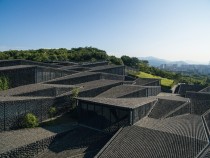
© Eiichi Kano
Roughly ten years ago, Wang Shu, the Chinese winner of the Pritzker Prize, designed the campus of the China Academy of Art, which is situated south of Hangzhou between high-rise blocks, the River Qiantang and the wooded hills of Xiangshan. In addition to bamboo and concrete, he used tiles and masonry from old buildings that had fallen victim to the rapid modernization of Hangzhou. The black roofs of the complex wind round courtyards and rise up like awnings over the volumes of the development.
For the extension of the area round the ethnological museum and conference centre, Kuma continued the application of both themes – roofs and tiles – in his own special way. Gently rising over the site of an old tea garden, the rhomboid forms ascend the slope in a series of steps, forming what seem to be small, distinct units within the 5,000 m² complex. Beneath this mosaic-like arrangement of inclined roof segments, forming a series of slopes and counterslopes, is a continuous, flowing internal space, the floor of which is distinguished by ramps and stepped areas. As a result, the rise and fall of the ground can be sensed at every point.
For the extension of the area round the ethnological museum and conference centre, Kuma continued the application of both themes – roofs and tiles – in his own special way. Gently rising over the site of an old tea garden, the rhomboid forms ascend the slope in a series of steps, forming what seem to be small, distinct units within the 5,000 m² complex. Beneath this mosaic-like arrangement of inclined roof segments, forming a series of slopes and counterslopes, is a continuous, flowing internal space, the floor of which is distinguished by ramps and stepped areas. As a result, the rise and fall of the ground can be sensed at every point.






